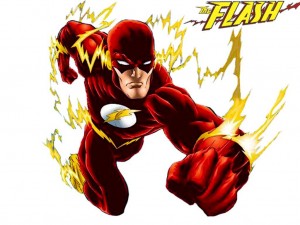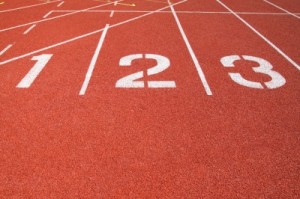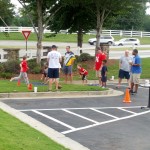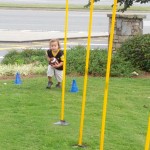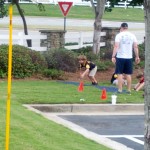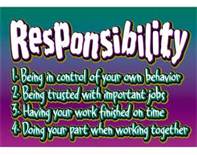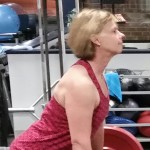Sports Performance Training
Coaches Corner: How to Assess Your Athletes’ Needs Part 2
0In part 1 of this article I talked about what you need to look for in assessing your athlete’s performance needs. Coaches are always looking for the best athletes, but you also need to be able to help develop the athletes that you have. The four primary areas that you need to consider while looking at your athletes are: The head, the arms, the torso and the legs. Most athletes will have issues with at least one of these areas. The younger the athletes the more potential for more issues there are, but do not let this make you believe that older athletes will not have any issues.
Once you figure out what is wrong the next step is to correct it. Again if you are qualified as a sports performance coach or have a strength and conditioning certification you can personally take charge of getting your athletes right. If you do not have any of the above, don’t just wing it or follow a book. You will end up doing more harm than good to your athletes. Find a qualified professional that can help you out and get your players right. What I do want to do is give you some simple remedies that can help you address each area of concern. These are things that will help you out if you are in the middle of your season or getting ready for the post-season and time is of the essence.
The Head: The head needs to be considered the steering device of the body. Basically it will navigate which direction you are moving in. This is not to say that you cannot look in one direction and move in another, but problem arise when the head moves too much when running. The simple fix for this is not controlling the head, but controlling the eyes. You want to get your athletes to focus on a spot in the horizon. I usually say to look at the point where the ground and the sky meet (floor and wall if indoors). If they can focus their eyes on this point their heads should stay still. The second fix is again is not with the head per say. A lot of times when an athlete’s head moves around you will notice that they are extremely tight in the neck and shoulders. Get your athletes to relax their necks, drop their shoulders and breathe through every motion and you will see a considerable difference in how they look.
The Arms: This is a bigger problem than most people realize because the only time it becomes and issue is when the athlete looks funny. In truth it is a huge problem and promotes bad movements. The first problem is when the arms cross the body. Just like the head moving from side to side this allows the body to twist while running, causing an inefficient stride pattern. The fix for this is to tell your athletes not to let their hands cross their mid-line (the buttons on a shirt or a neck tie). This allows the arms to move in a straight and symmetrical pattern for more efficiency. The second problem is the arms staying too low. This does not allow the athlete to drive efficiently. To help fix this problem you want to tell your athletes to move their hands from the cheek to the hip. The last problem seen with the arms is athletes moving just the lower arms or basically bending and straightening the elbow. Just like the last problem this does not allow athletes to drive effectively. Proper arm action is generated by the shoulders which allow the body to move more forcefully. Tell your athletes to drive arms down and back forcefully like they are trying to elbow someone behind them. All three tips together will allow your athletes to use their arms efficiently and effectively while they run.
The Torso: Problems with the torso are probably the most visible of the problems listed in this article. I know you have seen that athlete that looks like they are going to fall on their face with every step. Or the athlete that seem to stare up in the sky. Everyone in the world used to talk about Michael Johnson, arguably the best long sprinter of our times because of his upright posture. Different athletes will have different postures, but you do want to keep a few things consistent. Have your athletes run as balanced as possible with a slight lean forward. Also have them try to keep their shoulders square in the direction they are running. Lastly, they need to minimize the unnecessary body movements. One interesting note about correcting torso issues is that fixing other areas of the body will directly affect how the body moves, so you get more bang for the buck.
The Legs: The problems with the legs are probably the most common and widely varying of all the running problems. You can see athletes that don’t bend their knees, kick their legs out to the side or do butt kickers as they run. To fix these problems you need to tell your athletes to think about stepping over the opposite knee on every stride. This will allow them to drive the knee up and build power that they can apply to the ground. The ability to drive the knee up forcefully and then powerfully strike the ground is one of the biggest keys to improving speed. But all of this good work will go for nothing if you do not take care of the most common problem in athletes running wrong, especially younger athletes. To get your athletes to run properly you must get them to stop striking the ground with the whole foot or heel. You need to tell your athletes to land on the balls of their feet, in layman’s terms to hit the ground with the front of their feet. I do have to admit that this is not a simple problem to fix. It takes repeated drills and constant reminders to get athletes to change this issue, but if you remind them often it will help.
Now that you have assessed all the problems and gone through the simple fixes your athletes will be on a better path. I am not saying that they will now become the fastest players on the field or court, but you should be able to notice some differences. To make sure that they are getting the appropriate training you need to send them to a qualified professional. Coaches are in the positions they are in because of what they know about that sport or expertise in a profession. Yes we all know some things about other sports or training, but beyond the very basic information we have to remind ourselves that we do not know it all and getting the help that we need in other areas can only make us better. I hope that you did get something out of this article and decide to take a deeper look at your team and their needs. If you have any questions about this or any other sports performance subject please feel free to contact me. Now let’s go out there and coach these kids to the best of their abilities.
The Essence of Speed
0In athletics these days speed is everything. The more an athlete has the better the opportunities he/she can receive. Speed is the one attribute that is unquestionable. You can see it clearly as you watch things develop. It excites fans, drives opposing coaches and players crazy and ignites players no matter what sport. Speed in sports sets the tone of the game. It can help make decisions, change strategies, and elicit mistakes. Speed is royalty!
Team owners covet players with it. They will pay exorbitant amounts of money for an athlete that possesses great speed, even if that athlete is just about average in the sport. It is the one attribute that owners believe can take their franchise to the top. You will never see a sub-par athlete get a big contract because he has a lot of strength or is smart. But there are many examples of players making a career out of a sport they barely played because they are fast. Owners will take a chance on an athlete with speed just because of potential.
Coaches on all levels long for teams with speed at all positions. They can open up their playbooks and showcase dynamic schemes designed to get results fast. Many coaches will use players out of position just to utilize that player’s speed. The options for teams with speed are endless and a coach’s dream. At the younger ages the kid with the speed will always have the ball in his hands and majority of the time there is nothing the opposing team can do about it. With the older teams coaches will always try to get the fast kid on the field or court. They know that it can cause problems with their opponent’s game plan. For any coach, too much speed will never be a problem to have.
Players of all ages do everything to develop speed. They know that they can have better playing options if they are faster. Coaches will look at them when building their teams. They will most likely get the best playing time, and most of the time they may be able to get specific plays just for them. Parents these days are spending hundreds of dollars to get their kids speed training development. College and pro athletes spend most of their off-season working with coaches to increase their speed. Where else could a tenth of a second equate to half a million dollars. Speed is the key to everything athletics.
So with all of this uproar about speed and getting faster my question is; what is the essence of speed? In Webster’s Dictionary speed is defined as 1 the act or state of moving swiftly, 2 the rate of motion, 3the magnitude of a velocity irrespective of direction. In physics speed is defined as the rate or a measure of the rate of motion, especially distance traveled divided by the time of travel. In Lehman’s terms speed is getting from point A to point B in the least amount of time. When it comes to sports performance and speed development these definitions are the backbone of programs, but the means of getting there is along a different path. The rest of this article will cover my thought process behind my training philosophy. It will not cover any specific drills or movements, just the concepts that they are designed with.
When I start with a new athlete in my speed program the first thing that I cover is technical power development. Learning the technical power generating movement within each stride (leg movement) is the most important attribute in speed. If you watch younger athletes and slower athletes the main thing that you will see is that they have no power in their movements. Even if they are strong, the way they move will never generate the necessary power to run fast. So the first step in speed development is learning the power generating position which is getting the knees up.
The second step that I cover is how to use the generated power. Once they learn how to get their knees up or build power they need to effectively and efficiently use that power in their stride. Applying force or popping the ground will distribute the power built up in their legs to the ground, thus facilitating movement. The main thing that an athlete cannot do at this stage is land on flat feet. If this happens all of the generated power will be dissipated and resulting in slower speeds. So the second step in speed development is learning how to apply force to the ground.
The third step can be summed up in a scientific statement; “Every action has an equal and opposite reaction”. When it comes to speed development this covers the proper movement pattern needed to be fast. When the foot hits the ground the amount of force that is put into it will be given back. This results in a longer more powerful stride. But this only occurs if the athlete demonstrates the “opposite” part of the statement. Each stride must hit the ground under or behind the athlete so that the reactive force will be in the form of forward movement. So the third step is to powerfully hit the ground behind or under the body so that the reaction will be a longer more powerful stride.
This is the essence of speed. Being able to build power with each stride and apply that force to the ground under or behind the body at a quick rate!
This will cause each athlete to cover more ground with each stride at a faster pace. And if you remember the definitions from earlier speed is covering a specific distance in a shorter amount of time.
The Result: More speed and a faster athlete!!
Sports Performance Warm up Variations
0The warm-up is one of the most important parts of each training session, practice and game. It is what gets athletes ready to compete. A proper warm-up will increase the core body temperature, increase dynamic flexibility and mentally progress the athlete to game ready. The most important component of a great warm-up program is the progression. A great warm-up is not just a collection of exercises done randomly, but rather it is a precise sequence that will take the body from rest to optimal readiness. If you as a coach can master a great warm-up you can be assured that your athletes will be physically and mentally ready to perform.
Here are some warm-up variations that you can use to give your team that extra edge on each day’s event.
Warm-up #1
Set up an area 10 yards in length and as wide as you need it to be. Each drill will start with your athletes on the line in a running start position. As coach you give the command to go for each rep.
Lunge to Hamstring d
Lunge Rotation b
Knee Hugs d
Quad Pulls b
Frankenstein Walks d
Frankenstein Skips b
Straight Leg Runs d
High Knee Runs b
Forward/Backward Buttkicks d/b
Forward/Backward Skips d/b
Sprints 2-3 x 30 yards
Warm-up #2
Set up an area 15 yards in length and as wide as you need it to be. Each drill will start with your athletes on the line in a running start position. As coach you give the command to go for each rep.
Jog d/b
Forward/Backward Skip d/b
Forward/Backward Buttkicks d/b
Frankenstein Walks d
Frankenstein Skips b
Carioca d/b
Power Skips d
Bound Skips b
Backward Jog d
Sprint b
For a more detailed description of any drill please contact Julian Amedee at julian@sfxfitness.com.
Coaches Corner: How to Assess Your Athletes’ Performance Needs
0This article was the first in a three part series published in Game Day Youth Sports magazine in May 2013
Coaches today have a very tough job. They all have high expectations and minimal time to achieve them. This is going on from the professional ranks down to the youth leagues. Coaches are expected to win today no matter what the circumstances. But how do you know if your team is really ready to compete?
One thing that I always tell my athletes and parents is that to be a better “pick your sport” athlete you cannot just play more of that sport. The best football, soccer, baseball and basketball players all have one common characteristic; they are great athletes. So by default, a team with the best athletes will always be able to compete. Now the question becomes how to assess your athletes’ performance needs?
As a coach you have ample time to see what your athletes are doing right or wrong, but you do need to know what you are looking for. There are four primary areas that you want to consider while assessing your athletes:
The Head: Should be basically still and level while running. Problems occur when the head moves side to side or up and down. Issues with the head can lead directly to problems with the rest of the body.
The Arms: They must move aggressively from the shoulders and in a direct line from hip to cheek. Inefficiency develops when they cross the body or stay too low. Another major issue is when movement comes from the elbow.
The Torso: Like the head it should be relatively still but with a slight forward lean. Many of the issues of the torso are directly correlated to other areas of the body, but still need to be addressed. These issues include leaning forward, leaning back and twisting side to side.
The Legs: Motion should come from the knees with limited back kick. The feet also need to hit the ground on the balls. Major issues occur when the legs reach out in front, kick up behind or just barely come off of the ground. The most common issue in youth is landing on flat feet while running. This will derail any thoughts of being fast.
Once you identify these issues it is time to correct them and move forward. If you as a coach have adequate knowledge of speed and agility techniques then you can personally work on the problems. If you do not, don’t try to do some drills that you used to do when you were younger, they never have the same effect. You need to locate a qualified speed coach, like at SFX, to work with your athletes and get them right.
Now I know that you are asking if there is anything that you can do on your own if you want to help your athletes on a basic level. Well follow along for the next couple of months while I discuss each area in more depth and give you simple remedies to help correct each issue.
SFX running an obstacle course at Chick-Fil-A Roswell Corner’s Father son Football Night – 8/25/12
0Being an Athlete: Responsibility and Ownership
0Being an Athlete: Responsibility and Ownership
The most important trait you will notice from world class athletes is the responsibility. Now of course there are some exceptions to the rule, but the majority of them are pin point on how they handle themselves. They know what it takes to get to the top and go beyond the norm to make sure that they stay there. The second important trait is ownership. They take pride in what they do whether good or bad and take both the praise and the criticism for whatever happens. These traits aren’t things that they just pick up once they make it to the top. They are learned along the way to the top. They are taught by parents, teachers, mentors and coaches while they are still young.
The biggest dis-service that adults do for young athletes is doing everything for them. I know that they believe that what they are doing is in their child/athletes best interest. They think that by them doing all of the “extra” tasks they are allowing their athlete to just go out and perform and excel in their sport. But more often than not the opposite occurs. Since the athlete doesn’t have to do the behind the scenes work they never learn the commitment that it takes to be great. They never learn that their actions are directly associated with their result. If everything they do besides the game is easy then you are not really progressing as an athlete.
Last week I had a mom set up a session for her daughter who is a top soccer player in the area and has worked with me for a few years now. She told me that her daughter was upset about her conditioning and wanted to get back to working out. On the day of the session the other athlete that I was training her with had to reschedule so I was ready to work with her specifically. Her appointment time came and went without her showing so I called her mom and asked what happened. This is what her mom texted back:
“I am out of town and left my husband in charge. I scheduled with you and her and thought it was all good since she wanted to come. She fell asleep doing her summer school reading. She will apologize in person, pay for your time, reschedule and if you need her to do any chores at your place please sign her up. I am very upset that this has happened again. I had hoped she understood how important an adult’s work schedule was. Mortified!”
Later that day the daughter called and apologized and then came in the next day to apologize in person. I was so impressed by the mom putting responsibility and ownership on her daughter’s shoulders that I had to thank her and ask if I could write about it. Now I know some people might feel that all she said was tough on the daughter, but I do believe that it became a learning moment and will help mold her daughter for years to come.
Once athletes learn to be responsible for everything that they are doing and to take ownership in their choices and decisions they take a big step in becoming great. Being responsible isn’t always the popular thing to do, but knowing that you have bigger and better things ahead of you and taking ownership of your choices and actions can make the decisions worthwhile.
